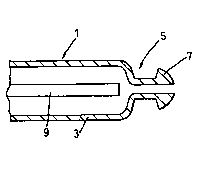Une partie des informations de ce site Web a été fournie par des sources externes. Le gouvernement du Canada n'assume aucune responsabilité concernant la précision, l'actualité ou la fiabilité des informations fournies par les sources externes. Les utilisateurs qui désirent employer cette information devraient consulter directement la source des informations. Le contenu fourni par les sources externes n'est pas assujetti aux exigences sur les langues officielles, la protection des renseignements personnels et l'accessibilité.
L'apparition de différences dans le texte et l'image des Revendications et de l'Abrégé dépend du moment auquel le document est publié. Les textes des Revendications et de l'Abrégé sont affichés :
| (12) Demande de brevet: | (11) CA 2274501 |
|---|---|
| (54) Titre français: | ENSEMBLE DE FAISCEAUX DE BARRES DE COMBUSTIBLES NUCLEAIRES |
| (54) Titre anglais: | ASSEMBLY OF NUCLEAR FUEL RODS BUNDLE |
| Statut: | Réputée abandonnée et au-delà du délai pour le rétablissement - en attente de la réponse à l’avis de communication rejetée |
| (51) Classification internationale des brevets (CIB): |
|
|---|---|
| (72) Inventeurs : |
|
| (73) Titulaires : |
|
| (71) Demandeurs : |
|
| (74) Agent: | LONG AND CAMERON |
| (74) Co-agent: | |
| (45) Délivré: | |
| (86) Date de dépôt PCT: | 1997-12-03 |
| (87) Mise à la disponibilité du public: | 1998-06-18 |
| Licence disponible: | S.O. |
| Cédé au domaine public: | S.O. |
| (25) Langue des documents déposés: | Anglais |
| Traité de coopération en matière de brevets (PCT): | Oui |
|---|---|
| (86) Numéro de la demande PCT: | PCT/GB1997/003341 |
| (87) Numéro de publication internationale PCT: | WO 1998026425 |
| (85) Entrée nationale: | 1999-06-04 |
| (30) Données de priorité de la demande: | ||||||
|---|---|---|---|---|---|---|
|
L'invention concerne une barre d'extraction (1) pour permettre l'assemblage d'un élément de combustible nucléaire en chargeant les barres de combustible nucléaires comprenant des pastilles de combustible à l'intérieur d'une structure de soutien en forme de grilles espacées. La barre d'extraction (1) possède un corps tubulaire dans lequel au moins une partie antérieure est fabriquée en fibre de carbone.
A puller rod (1) is provided for use in assembling a nuclear fuel element by
loading nuclear fuel rods containing nuclear fuel pellets into a support
skeleton in the form of spaced apart grids. The puller rod (1) has a tubular
body in which at least a forward or leading portion of the body is made of
carbon fibre.
Note : Les revendications sont présentées dans la langue officielle dans laquelle elles ont été soumises.
Note : Les descriptions sont présentées dans la langue officielle dans laquelle elles ont été soumises.

2024-08-01 : Dans le cadre de la transition vers les Brevets de nouvelle génération (BNG), la base de données sur les brevets canadiens (BDBC) contient désormais un Historique d'événement plus détaillé, qui reproduit le Journal des événements de notre nouvelle solution interne.
Veuillez noter que les événements débutant par « Inactive : » se réfèrent à des événements qui ne sont plus utilisés dans notre nouvelle solution interne.
Pour une meilleure compréhension de l'état de la demande ou brevet qui figure sur cette page, la rubrique Mise en garde , et les descriptions de Brevet , Historique d'événement , Taxes périodiques et Historique des paiements devraient être consultées.
| Description | Date |
|---|---|
| Exigences relatives à la nomination d'un agent - jugée conforme | 2020-09-02 |
| Exigences relatives à la révocation de la nomination d'un agent - jugée conforme | 2020-09-02 |
| Exigences relatives à la révocation de la nomination d'un agent - jugée conforme | 2020-09-01 |
| Exigences relatives à la nomination d'un agent - jugée conforme | 2020-09-01 |
| Le délai pour l'annulation est expiré | 2002-12-03 |
| Demande non rétablie avant l'échéance | 2002-12-03 |
| Réputée abandonnée - omission de répondre à un avis sur les taxes pour le maintien en état | 2001-12-03 |
| Lettre envoyée | 1999-12-10 |
| Inactive : Transfert individuel | 1999-11-04 |
| Inactive : Page couverture publiée | 1999-08-31 |
| Inactive : CIB attribuée | 1999-08-30 |
| Inactive : CIB en 1re position | 1999-08-10 |
| Inactive : Lettre de courtoisie - Preuve | 1999-07-27 |
| Inactive : Notice - Entrée phase nat. - Pas de RE | 1999-07-21 |
| Demande reçue - PCT | 1999-07-16 |
| Demande publiée (accessible au public) | 1998-06-18 |
| Date d'abandonnement | Raison | Date de rétablissement |
|---|---|---|
| 2001-12-03 |
Le dernier paiement a été reçu le 2000-11-22
Avis : Si le paiement en totalité n'a pas été reçu au plus tard à la date indiquée, une taxe supplémentaire peut être imposée, soit une des taxes suivantes :
Veuillez vous référer à la page web des taxes sur les brevets de l'OPIC pour voir tous les montants actuels des taxes.
| Type de taxes | Anniversaire | Échéance | Date payée |
|---|---|---|---|
| Taxe nationale de base - générale | 1999-06-04 | ||
| Enregistrement d'un document | 1999-11-04 | ||
| TM (demande, 2e anniv.) - générale | 02 | 1999-12-03 | 1999-11-23 |
| TM (demande, 3e anniv.) - générale | 03 | 2000-12-04 | 2000-11-22 |
Les titulaires actuels et antérieures au dossier sont affichés en ordre alphabétique.
| Titulaires actuels au dossier |
|---|
| BRITISH NUCLEAR FUELS PLC |
| Titulaires antérieures au dossier |
|---|
| GRAEME MICHAEL WIGG |
| MICHAEL KEVIN BRIDGES |
| PAUL HUGH DESBOROUGH |